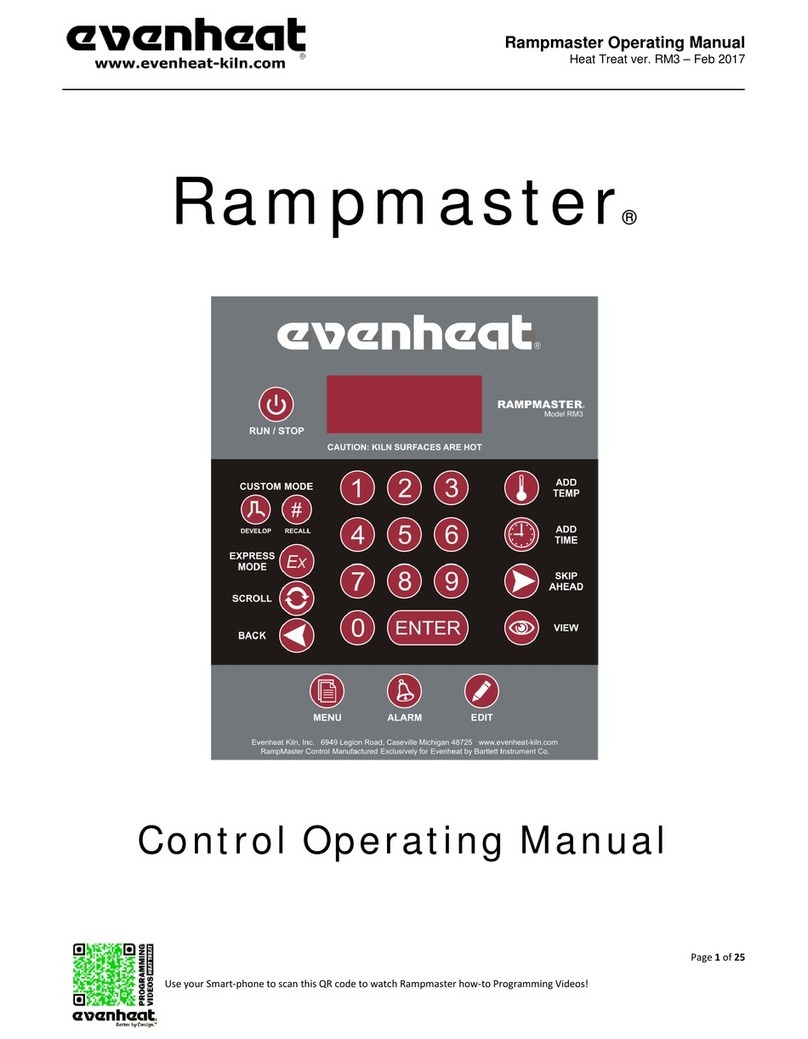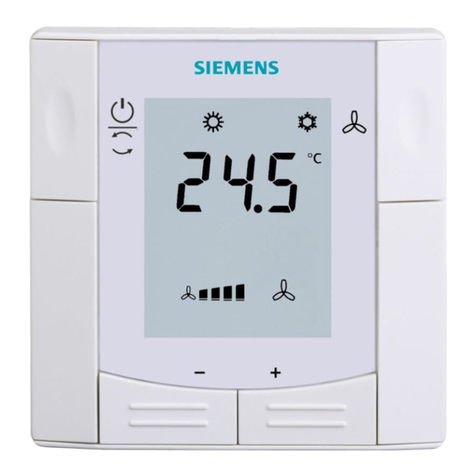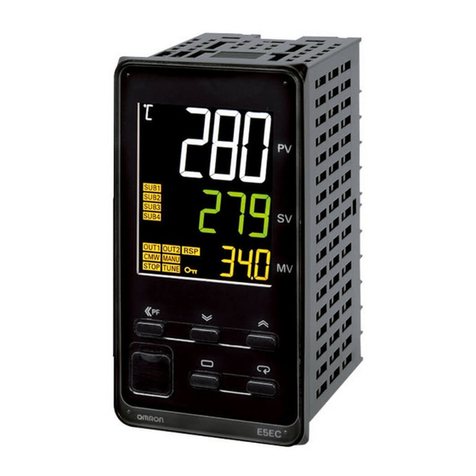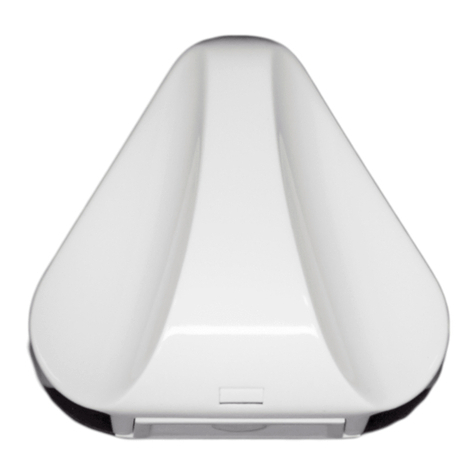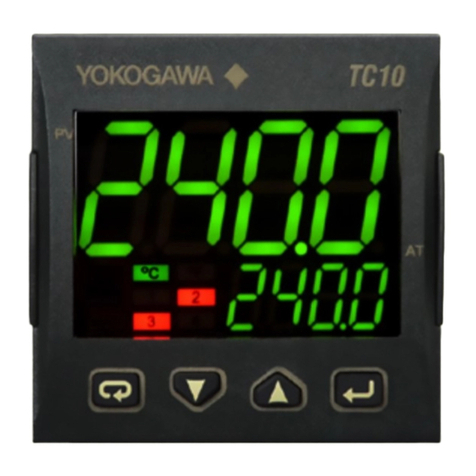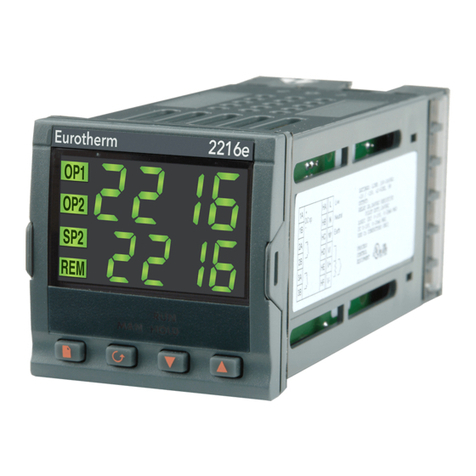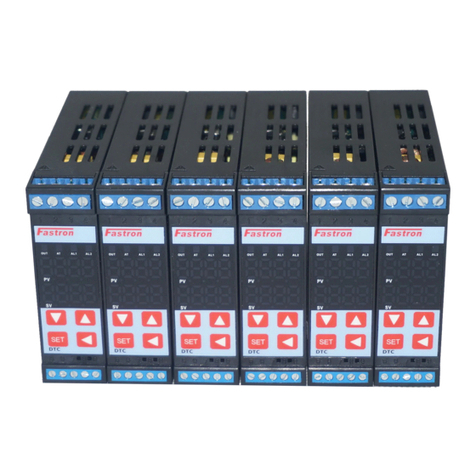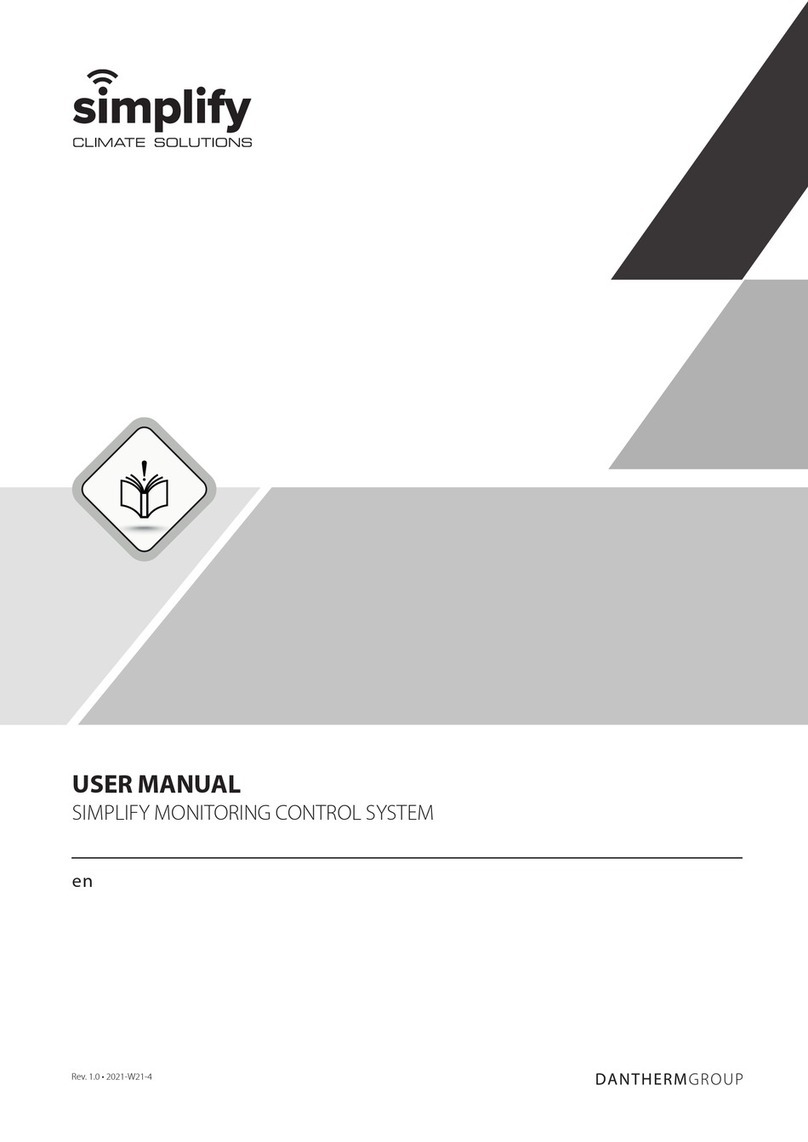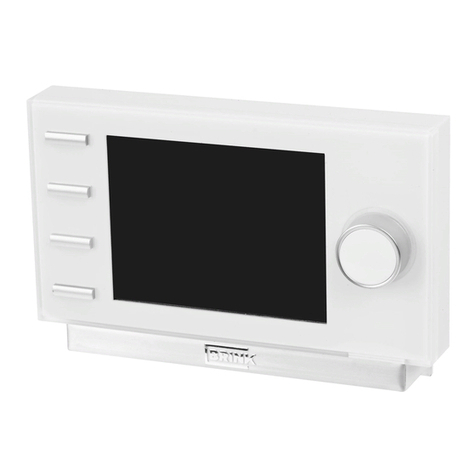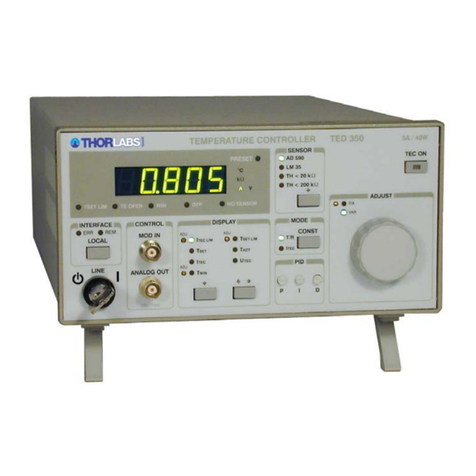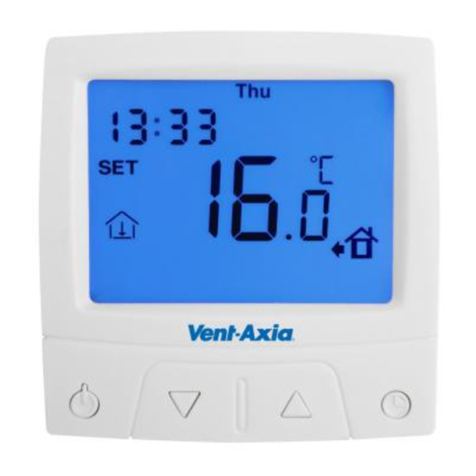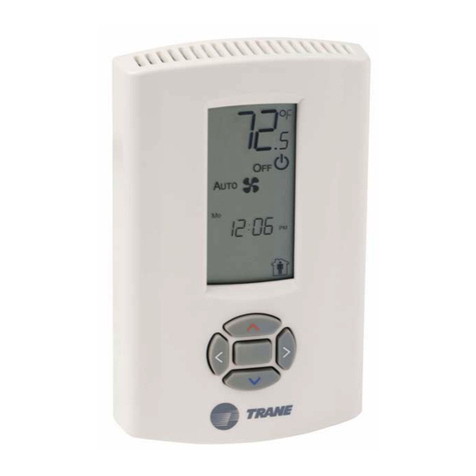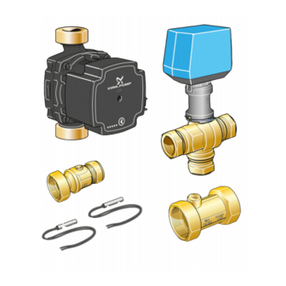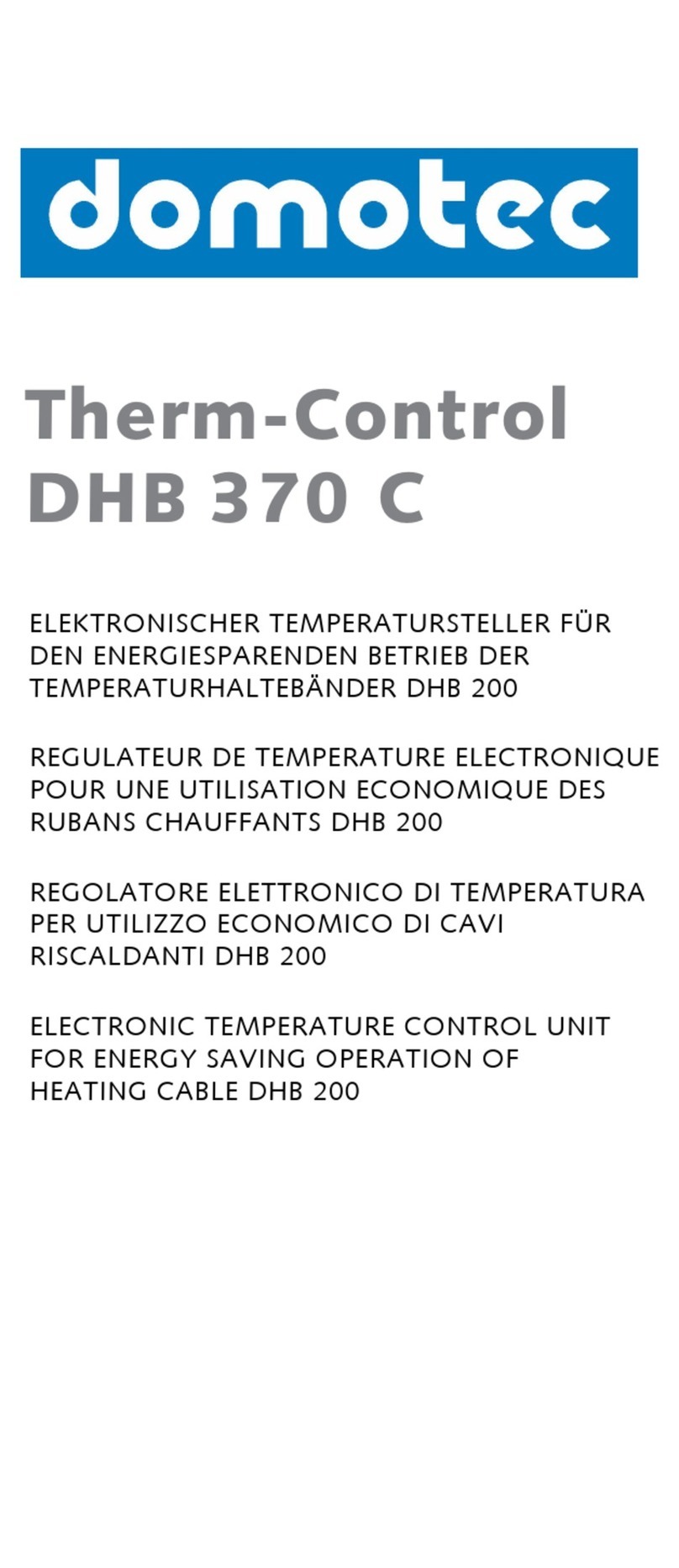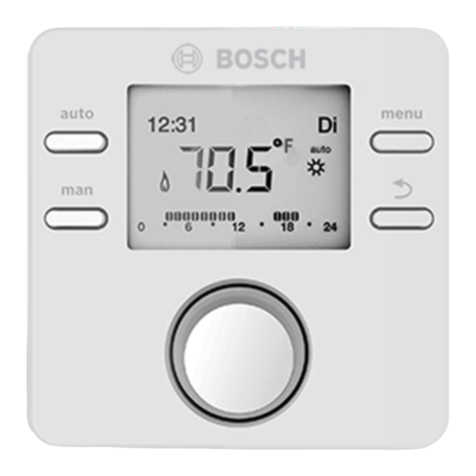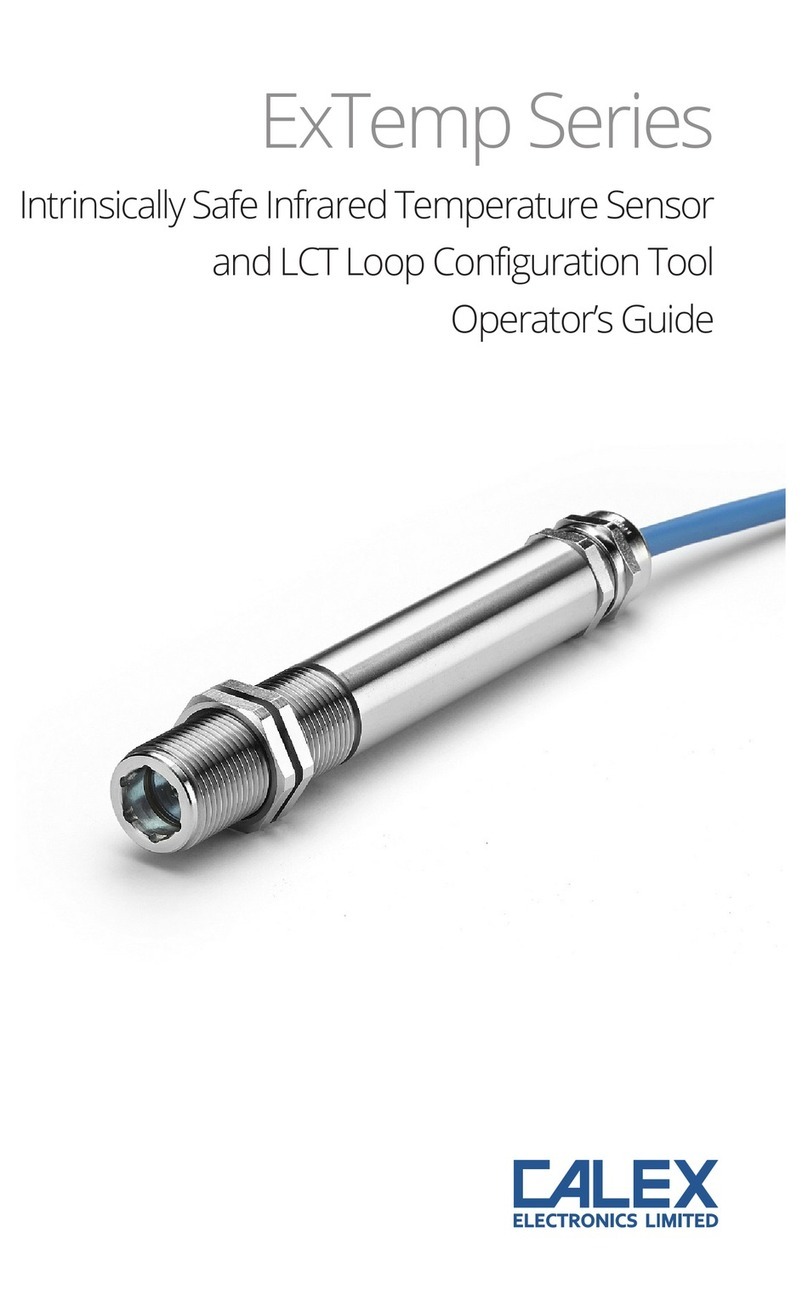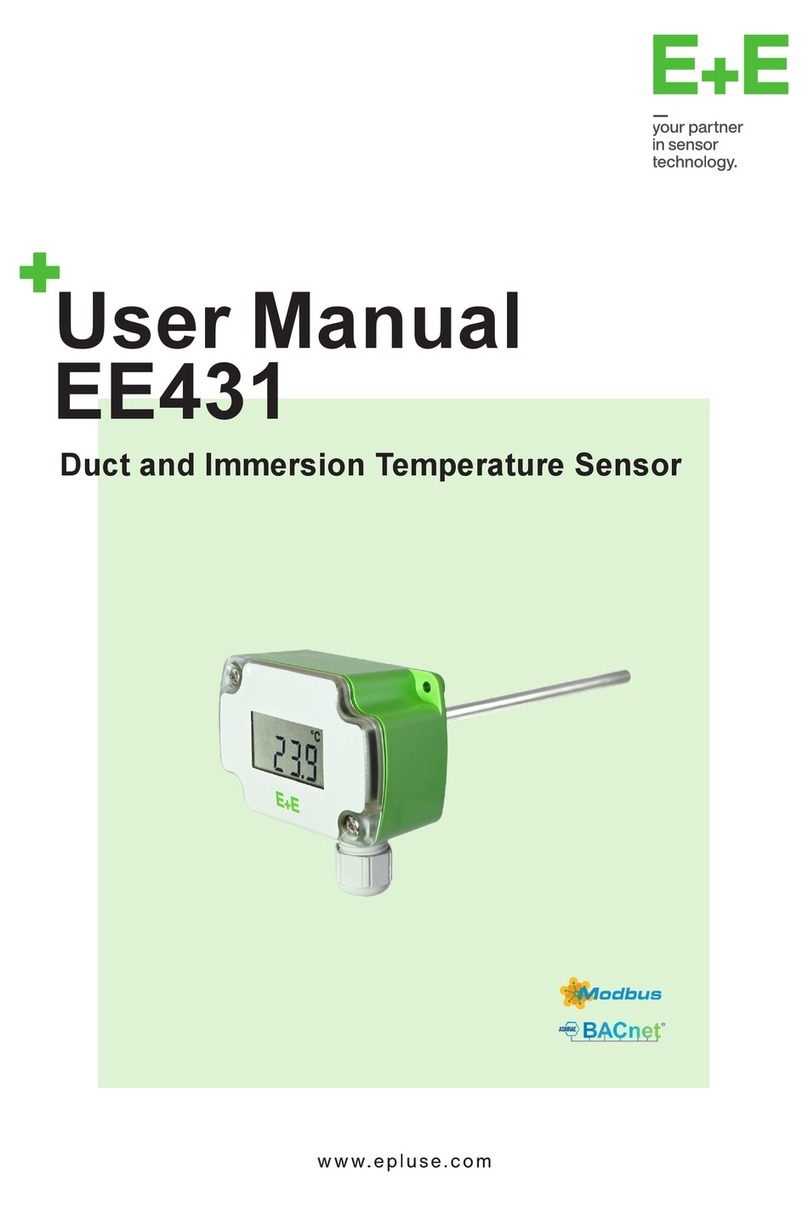Evenheat Set-Pro User manual

Set-Pro w/ Express Mode Operating Manual
Heat Treat version - March 2012
Page 1of 17
Use your Smart-phone to scan this QR code to watch Set-Pro how-to Programming Videos!
For Use with Studio Pro STP and Kingpin 88 Models with “EX” at End of Serial Number
For Use with KF, KH and HT-1 Set-Pro Equipped Ovens with Serial Number’s 102077 and Above
SET-PRO
w/ Express Mode
HEAT TREATING
Control Operating Manual

Set-Pro w/ Express Mode Operating Manual
Heat Treat version - March 2012
Page 2of 17
Use your Smart-phone to scan this QR code to watch Set-Pro how-to Programming Videos!
Thank you for purchasing a Set-Pro equipped oven from Evenheat. The Set-Pro offers Custom Mode programming to allow the heat treater complete
control over all heat processing decisions. Please take some time to read this manual. Not only does it cover the basics, it also contains some little gems
that are sure to make your command of the Set-Pro a thoroughly rewarding experience.
The Set-Pro w/ Express Mode offers four programming modes: Custom (Used for Heat Treating), Metal Clay Express, Glass Express and Ceramic Express
Custom Mode is designed for the creation of custom heat treating programs.
Metal Clay Express Mode is designed exclusively for firing Art Clay and PMC brands of metal clay. Preset firing programs for each brand make
programming easy and accurate. Knife makers may be interested in this particular art, check it out!
Glass Express Mode is designed exclusively for glass firing. It’s quick, easy and accurate using preset firing parameters. Simply answer a few
questions and you’re ready to fire.
Ceramic Express Mode is designed exclusively for ceramic firing. Choose your cone number and firing speed and the Set-Pro does the rest
automatically.
This manual describes the use of the Set-Pro w/ Express Mode as it relates to using the Custom Mode for Heat Treating. For Set-Pro w/ Express Mode
manuals relating to using the Metal Clay Express Mode, Glass Express Mode and Ceramic Express Mode please refer to the manuals disc included with
your oven, visit our web site at www.evenheat-kiln.com or contact us at info@evenheat-kiln.com.
CAUTION: The Set-Pro is used to control temperature, it is not a safety devise. Never leave the oven unattended while firing. Check on the oven at the
end of the heat treat process to ensure process has completed as planned.
CAUTION: Throw control power switch, located on oven control panel, to the OFF position (O) when not in use.
Table of Contents
Quick Step Programming
Quick Steps for Custom Mode Programming .................................3
Detailed Programming
Set-Pro Key Descriptions ................................................................4
Custom Mode Programming (Detailed) .........................................5
On-the-Fly Features
Adding Time to a Hold....................................................................7
Adding Temperature to a Hold....................................................... 7
Skipping Ahead to the next Segment ............................................. 7
View Segment Feature ...................................................................7
Programming & Use Features
Initialization ...................................................................................8
Idle .................................................................................................8
Beginning and End Process Alarms ................................................8
Program Review.............................................................................9
Start Now .......................................................................................9
Storing a Custom Mode Program...................................................9
Selecting and Running a Custom Mode Program ...........................9
Stopping the Program.................................................................... 9
4 User Programs in Custom Mode................................................. 9
8 Segments per Custom Mode Program ........................................ 9
Programming a Time Value............................................................ 9
Temperature Rate Options .......................................................... 10
Using UP & Down Arrow Keys...................................................... 10
Number of Segments................................................................... 10
Writing Over Data........................................................................ 10
Clearing Function......................................................................... 10
Fahrenheit or Celsius ................................................................... 10
Maximum Programmable Temperature ...................................... 10
Firing Down to Room Temperature ............................................. 10
Delay Start Feature ...................................................................... 11
Display & Heat Treat Data
Set-Pro Display Conditions........................................................... 12
Set-Pro Display Messages ............................................................ 12
Key Function Table....................................................................... 13
Set-Pro Error Messages................................................................ 13
Heat Treat Data ........................................................................... 14
Oven Trouble Shooting ................................................................ 17

Set-Pro w/ Express Mode Operating Manual
Heat Treat version - March 2012
Page 3of 17
Use your Smart-phone to scan this QR code to watch Set-Pro how-to Programming Videos!
Use this Quick Guide to Immediately Begin the Custom Mode Programming Process
This Quick Guide to programming is a fairly straight forward, key-by-key approach to programming your heat treat program. It doesn’t go into much detail
beyond what keys to press for most heat treating programs. If you were to rip a page out of this manual and tack it to the wall, it would be this page. For
more detailed programming instructions check out page 5.
The Custom Mode allows the creation of your own, individual heat treating programs. You choose the rate of temperature increase, the temperature you
want to achieve and any hold time once you’re there. These 3 items, taken together, create what’s known as a segment. Generally speaking, heat treat
programs use only 1 segment.
Quick Steps for Custom Mode Programming
1. Throw the power switch on the oven control panel to the On position.
2. The Set-Pro begins its initialization process and the display will illuminate.
3. The Set-Pro will finish its initialization process and then display IdLE (Idle).
4. Press the Enter key one time to begin the programming process. The display will read either, GLAS,ALAr, M-C, CEr or CUSt.
5. Use the Up or Down arrow keys to make the display read CUSt (Custom Mode) if it does not already.
6. Press the Enter key. USr is displayed along with some number.
7. Use the Up arrow key to choose. You’re choosing which of the 4User program numbers will be used to store your program. Your choices are 1 thru 4.
8. Press the Enter key. SEG is displayed along with some number.
9. Use the Up or Down arrow keys to choose. You’re choosing the total number of segments used in the program. Your choices are 1 thru 8. Generally
speaking, heat treat programs usually use only 1 segment.
10. Press the Enter key. rA 1 is displayed along with some number.
11. Use the Up and Down arrow keys to choose. You’re programming the temperature rate (°/hr.) for this segment. Generally speaking, heat treat
programs usually go As Fast As Possible up to temperature.
12. Press the Enter key. °F 1 is displayed along with some number.
13. Use the Up and Down arrow keys to choose. You’re programming the temperature set point for this segment.
14. Press the Enter key. HLd 1 is displayed along with some number.
15. Use the Up and Down arrow keys to choose. You’re programming the hold time for this segment.
16. Press the Enter key. rA 2 is displayed. Repeat steps 11 thru 14 for all remaining segments.
17. Once all remaining segments have been programmed the display will read rEdI (Ready).
18. Press the Enter key to begin the heat treating process. The Set-Pro is now running your Custom heat treat program.
When the process is complete the display alternates between CPLt and total process time. Press the Start/Stop key at this point will cause the display to
briefly read StOP and then IdLE.
You may stop the heat treat process at any time by pressing the Enter key. Doing so will cause the program to stop and StOP will briefly be displayed.

Set-Pro w/ Express Mode Operating Manual
Heat Treat version - March 2012
Page 4of 17
Use your Smart-phone to scan this QR code to watch Set-Pro how-to Programming Videos!
Set-Pro Key Layout & Key Descriptions
Start/Stop - Enter
The Start/Stop key starts and stops the heat treat process. It’s also used to enter or store heat treat program information during the programming process.
UP Arrow –VIEW SEG –SKIP SEG
Used to select values when programming and allows for Viewing the current running segment as well as performing the Skip Ahead feature.
Down Arrow –REVIEW
Used to select values when programming and allows for the Review program feature.
See the Set-Pro Key Function Table on page 13, for more detailed key information.
Display - Large, bright LED display
can be seen from a distance.
F or °C - The Set-Pro can be set to display
in either Fahrenheit or Celsius.

Set-Pro w/ Express Mode Operating Manual
Heat Treat version - March 2012
Page 5of 17
Use your Smart-phone to scan this QR code to watch Set-Pro how-to Programming Videos!
Custom Mode Programming (Detailed)
The Custom Mode is a method of programming that allows you to precisely define every aspect of the heat treating process. You’re creating a custom
program designed for the work at hand. During programming you will be asked to enter in data for rate of temperature increase (or decrease), the set
point temperature you would like to reach and hold time at the set point temperature. Most heat treat programs are simple, 1 segment affairs that ramp
up to temperature and hold that temperature for a period of time, then shut off. The Set-Pro does allow for heat treating applications that involve multiple
firing steps. We have included some basic heat treat data at the end of this manual to assist you developing your heat treat programs.
1. Throw the power switch on the oven control panel to the On position.
2. The Set-Pro begins its initialization process and the display will illuminate.
3. The Set-Pro will finish its initialization process and then display IdLE (Idle).
Idle simply means the Set-Pro is at rest and is not running any programs.
4. Press the Enter key one time to begin the Custom Mode programming process. The display will read GLAS,ALAr, M-C, CEr or CUSt.
The Set-Pro includes preset programs designed to fire glass, metal clays, ceramic as well as offering Custom programs for heat treating.
These choices are displayed as:
GLAS –Glass Express Mode
ALAr –Beginning and End Process Alarms
M-C –Metal Clay Express Mode
CEr –Ceramic Express Mode
CUSt –Custom Mode
5. Use the Up or Down arrow keys to make the display read CUSt (Custom Mode) if it does not already.
6. Press the Enter key. The display will read USr along with some number.
The Set-Pro needs to know which of the 4 available locations you would like to store your Custom Mode program. In other words: a program
number. Your choices are 1 thru 4.
7. Use the Up arrow key only to select the desired program number.
8. Press the Enter key. The display will read SEG along with some number.
The Set-Pro needs to know the total number of segments you would like to use for the Custom Mode program. A Segment consists of these 3
questions: Rate: how fast am I supposed to get to temperature? Set Point: what temperature am I going to? Hold Time: the amount of time to
hold at my Set Point temperature?
You can use up to 8 segments for your program. Your choices are 1 thru 8. Most heat treat programs usually use 1 segment.
9. Use the Up and Down arrow keys to select desired number of segments to be used in the Custom program.
10. Press the Enter key. The display will read rA-1 along with some number.
The Set-Pro is asking for the desired temperature rate to be used in segment 1. rA stands for Rate and the 1 means you’re programming the
rate of temperature change for segment 1.
Rate means speed and you need to tell the Set-Pro how fast you want the temperature to change. Rate for the Set-Pro is programmed in
degrees per hour (°/hr.). The choice is yours.
Most heat treat programs use a temperature rate of “As Fast As Possible”. “As Fast As Possible” is programmed in as 9999 or Full, see page 10
for detailed information.

Set-Pro w/ Express Mode Operating Manual
Heat Treat version - March 2012
Page 6of 17
Use your Smart-phone to scan this QR code to watch Set-Pro how-to Programming Videos!
Custom Mode Programming (Detailed) –continued from previous page
11. Use the UP and DOWN arrow keys to select your desired rate.
12. Press the Enter key. The display will read °F 1 (°C 1 if using Celsius).
The Set-Pro is asking for the temperature set point you wish to reach in segment 1. °F stands for the temperature set point (°C is displayed if
you’re using the Celsius scale) and the 1 means you’re programming the temperature you would like to reach in segment 1.
The choice is yours.
13. Use the Up and Down arrow keys to select your set point temperature.
14. Press the Enter key. The display will read HLd1 along with some number.
The Set-Pro is asking for the amount of time you wish to hold at the set point temperature. HLd stands for Hold (a.k.a. soak or dwell) and the 1
means you’re programming the amount of time you want the temperature to stay at the segment 1 temperature once you reach it.
Hold time is programmed in hours and minutes. Values to the left of the decimal point are hours and values to the right of the decimal are
minutes. You do not have to hold at temperature if you don’t want to, in which case hold time would be 0.
15. Use the Up and Down arrow keys to select your desired hold time.
16. Press the Enter key. If you have chosen to use more than 1 segment for your firing the display will read rA 2 along with some number. If you have
chosen to use only 1 segment for this firing skip ahead to line #21 for further instruction.
The Set-Pro is asking for temperature rate, this time for segment 2.
17. Use the Up and Down arrow keys to select your desired rate.
18. Press the Enter key. The display will read °F 2 along with some number.
The Set-Pro is asking for the temperature set point, this time for segment 2.
19. Use the Up and Down arrow keys to select your desired temperature set point.
20. Press the Enter key. The display will read HLd2 along with some number.
The Set-Pro is asking for the amount of hold time at your temperature set point, this time for segment 2.
As you can see from the emerging pattern, the Set-Pro will continue to ask the same three questions: rate, temperature and time for all remaining
segments. Just keep answering the questions.
21. Once all your segments are programmed the Set-Pro will display rEdI which means it’s ready to run your Custom Mode program.
22. Press the Enter key to begin the heat treating process. The Set-Pro is now running your Custom heat treat program.
When the heat treat process is complete the display alternates between CPLt and total process time. Pressing the Start/Stop key at this point will cause
the display to briefly read StOP and then IdLE.
The Set-Pro automatically stops running the heat treat program once complete. However, you may always stop a heat treat process in progress, at any
time, by pressing the Start/Stop key. StOP is displayed briefly and then IdLE.

Set-Pro w/ Express Mode Operating Manual
Heat Treat version - March 2012
Page 7of 17
Use your Smart-phone to scan this QR code to watch Set-Pro how-to Programming Videos!
On-The-Fly Features
The Set-Pro contains a set of features that allow you to adjust and tweak the firing while it’s actually running! We’ve dubbed these features as “On-the-
Fly”. With these features it’s possible to add a little bit of time to a hold if needed, add a little bit of temp to a hold or just leave the segment entirely and
move to the next segment (in multi-segment programs).
Adding Time to a Hold
During a hold period it may be necessary to add just a little more time to the programmed hold time. The Set-Pro allows you to add time to a hold in 5
minute increments.
To Use the Add Time Feature
While holding at a temperature (display reads temperature along with remaining hold time), repeatedly press the UP arrow key until the display
reads tME (stands for time). Press the ENTER key one time. You have now added 5 minutes to the hold time. The display will go back to reading
temperature and remaining hold time and you will notice that 5 minutes has been added to the hold. You may use this procedure as often as
necessary during a hold to get the hold time you desire. It should be noted that the Adding Time to a Hold feature is a temporary adjustment
only. That is, it does not change the program stored in memory.
Adding Temperature to a Hold
During a hold period it may be necessary to add just a little extra temperature to the programmed set point temperature. The Set-Pro allows you to add
more temperature in °5 increments.
To Use the Add Temperature Feature
While holding at a temperature (display reads temperature along with remaining hold time), repeatedly press the UP arrow key until the display
reads tMP (stands for temperature). Press the ENTER key one time. You have now added 5 degrees to the set point temperature. Once set, the
display will go back to reading temperature and remaining hold time. You may use this procedure as often as necessary during a hold to get the
hold temperature you desire. It should be noted that the Adding Temperature to a Hold feature is a temporary adjustment only. That is, it does
not change the program stored in memory.
Skipping Ahead to the Next Segment
During multi-segment heat treating processes it may become desirable to stop what you’re currently doing and skip ahead to the next segment in the
program.
To Use the Skip Ahead Feature
At any time during the heat treating process press the UP arrow key one time. The display will eventually read SStP (stands for Skip Step). When
it does, press the ENTER key one time. You have now skipped to the next programmed segment. If you need to continue to skip ahead even
further feel free to do so. Once you skip the display will go back to reading temperature.
View Segment Feature
At any point during the heat treat process you may press the UP arrow one time to display the current action (ramping or holding) and current segment.
This will tell you if you’re ramping or holding and which segment you’re doing this in. After a moment or two the display will go back to normal operation.

Set-Pro w/ Express Mode Operating Manual
Heat Treat version - March 2012
Page 8of 17
Use your Smart-phone to scan this QR code to watch Set-Pro how-to Programming Videos!
Programming and Use Features
Initialization (Boot-Up)
When the Set-Pro is powered up it goes through an initialization process. Various data is displayed until the initialization is complete and the display reads
IdLE.
IdLE (Idle)
Idle simply means the Set-Pro is not running any firing programs at the moment.
Beginning and End of Process Alarm Feature
The Set-Pro allows you to set a special Beginning of Process Alarm and End of Process Alarm to sound at very important heat treating points.
The Beginning of Process Alarm sounds when you have reached your process temperature and the material is beginning to hold/soak at process
temperature. This alarm basically gives you a heads up that your material has entered the soak/hold portion of the heat treat process and it
won’t be long before it needs to be quenched.
The End of Process Alarm sounds when your material has completed its heat treat operation and is ready to quench. Action on your part is
required at this point of the process and this End of Process alarm lets you know. If you’ve ever missed the opportunity to quench at
temperature, this End of Process Alarm is made just for you!
From the standpoint of actual use, the End of Process Alarm is arguably the most valuable. When you’re heat treating, knowing when
the heating cycle is completed and the material is ready to quench is critical. The End of Process alarm let’s you know when this
occurs and gives you the opportunity to react properly and in time, take advantage of it!
To choose your desired Beginning and End of Process Alarms combination:
1. Throw the power switch on the kiln control panel to the On position.
2. The Set-Pro begins its initialization process and the display will illuminate.
3. The Set-Pro will finish its initialization process and then display IdLE (Idle). Idle simply means the Set-Pro is at rest and is not running any
programs.
4. Press the Enter key one time to begin the Alarm setting process. The display will read GLAS,ALAr, M-C, CEr or CUSt.
5. Use the Up or Down arrow keys to make the display read ALAr (Process Alarm) if it does not already.
6. Press the Enter key. The display will read either OFF, bEGn, End or botH. These choices allow you to decide at what point the Process Alarms
function. You can set them to both be silent (OFF), have just the beginning of process alarm sound (bEGn), have just the end of process alarm
sound (End) or have both of them sound (botH).
OFF = Beginning of Process and End of Process Alarms are both Off and will not sound.
bEGn = Beginning of Process Alarm will sound, End of Process Alarm will not sound.
End = End of Process Alarm will sound, Beginning of Process alarm will not sound.
botH = Both the Beginning and End of Process Alarms will sound.
7. Use the Arrow keys to choose your desired process alarm setting. Press the Enter key to store your choice.
8. Press the Enter key. The display will read IdLE which stands for Idle. You Process Alarm choice is now programmed.
Once you have chosen which combination of process alarms you desire, your choice stays programmed for all remaining programs and use until you
decide to choose a different combination.
To silence any alarms simply press one of the arrow keys.

Set-Pro w/ Express Mode Operating Manual
Heat Treat version - March 2012
Page 9of 17
Use your Smart-phone to scan this QR code to watch Set-Pro how-to Programming Videos!
Programming and Use Features Continued from Previous Page
Program Review
It’s always best to review your program before starting it. When the controller is reading IdLE just press the REVIEW key and the display will automatically
show you what’s programmed. Just watch. When it’s done reviewing rEdI will be displayed. Press Start/Stop key to start the program. If it’s not what you
want, Press the Start/Stop key again to get to IdLE and enter a new program.
Start Now
For you brave souls out there who want to skip the program review you can get to the rEdI command quickly by pressing the REVIEW key twice (when IdLE
is displayed). This bypasses the review process and gets you directly to rEdI. Just press the Start/Stop to start the program.
Storing a Custom Mode Program
As you go through the Custom Mode programming process and complete it, your program is automatically stored in the program number you selected at
the beginning of the programming process.
Selecting and Running a Custom Mode Program
At some point you are likely to have set all 4 Custom Mode programs set to something you like and want to run again and again. The Set-Pro allows you to
quickly select the program you desire.
To Select a Custom Mode Program
From IdLE press the Enter key one time. Use the UP arrow key to choose the Custom Mode program you wish to run and then press the DOWN
arrow key. The Set-Pro display automatically cycles through the chosen program settings and then displays rEdI. Simply press Start to begin the
firing.
Stopping the Program
At any time you may stop the heat treat process while it’s running by pressing the Start/Stop key. The display will briefly read StOP and then read IdLE
along with chamber temperature.
4 User Programs in Custom Mode
The Set-Pro allows the heat treater to save up to 4 Custom Mode programs in memory. Your programs remain in these 4 locations indefinitely and can be
recalled or changed at any time.
8 Segments per Custom Mode Program
The Set-Pro allows you to use up to 8 segments for each Custom Mode firing program. Typical heat treat programs use only 1 segment. However, if you do
need more than 1, you got ‘em!
Programming a Time Value
The Set-Pro accepts time as Hours and Minutes. When programming a time value, a red dot will illuminate in the middle of the four display digits.
Numbers to the left of the dot indicate hours and numbers to the right of the dot indicate minutes.

Set-Pro w/ Express Mode Operating Manual
Heat Treat version - March 2012
Page 10 of 17
Use your Smart-phone to scan this QR code to watch Set-Pro how-to Programming Videos!
Programming and Use Features Continued from Previous Page
Temperature Rate Options
Temperature rate is programmed in degrees per hour (°/hr.). Heat treat processes usually go As Fast As Possible”. You can do this in two ways. You can
program in the maximum rate of 9999 which works fine or use the FULL command. The FULL command instructs the controller to go Full on (or Full off) to
the set point temperature. To set your rate to FULL simply press the down arrow key until the display stops at 0000, then release the key. Wait a moment
or two then press the down arrow one time. The display will read FULL.
Using the UP and DOWN Arrow Keys
When using the arrow keys, especially when holding them down, the “tens” position will change first then the “hundreds” position will change then the
“thousands” position will change. This process is designed to get you where you want to go a little faster, and easier. Another twist to this feature allows
you to “tap” the button to change the position slowly. For instance: let’s say you’re holding down the up arrow key and the hundreds position is changing.
Simply let go of the arrow key and press it once to increment the hundreds up by 1. Press it once again and it moves up by 1 again. And so on and so forth.
This feature is true when any position is the one being changed. We hope you find it useful.
Number of Segments
The Set-Pro can control up to 8 segments per use or program. However, that doesn’t mean that you need to use all 8. If your program only needs 1 or 2
segments to operate, great, use only 1 or 2. When it comes time to choose just select the number of segments you need.
Writing Over Data
You will want to change the data in your Custom Mode programs at some point. We expect this as you try new techniques and fine tune your skills. When
you do, you’ll see the old firing data as you’re programming in the new data. Simply key in the new data as though the old never existed.
Clearing Function
There is no feature that allows you to perform an “ALL CLEAR” function, i.e. set all the settings to 0. Sorry. We understand the desire for such a feature but
it’s really not necessary.
Fahrenheit or Celsius
Your Set-Pro was set at the factory for use in the Fahrenheit or Celsius temperatures scales. If programmed to the Fahrenheit scale you will see °F when
programming your set point temperatures. If set to Celsius you will see °C when programming your set point temperature. You will also note that a small,
red dot will be illuminated at the bottom right of the Set-Pro display area to indicate a Celsius temperature. This small, red dot is not illuminated when
using the Fahrenheit scale. If you would like to change which temperature scale you are using please consult Evenheat if you wish to adjust this setting.
Maximum Programmable Temperature
The maximum temperature that can be programmed in the Set-Pro is 2350°F (1288°C).
Firing Down to Room Temperature
Over the years we’ve seen users attempt to program their ovens to come down to room temperature at the end of the heat treat process. They have
literally programmed in 72° as the last segment temperature. Don’t do this. If your actual room temperature goes above what you have programmed the
firing won’t end until the room temp drops, you get an error or you stop the firing. If you want to control the cooling down to some low, final temperature
don’t make it room temperature. We suggest 200° or above.

Set-Pro w/ Express Mode Operating Manual
Heat Treat version - March 2012
Page 11 of 17
Use your Smart-phone to scan this QR code to watch Set-Pro how-to Programming Videos!
Programming and Use Features Continued from Previous Page
Delay Start Feature
The Set-Pro can delay the start of your firing for up to 100 hours. This feature becomes valuable when different electrical rates are charged at different
times of the day.
To Use the Delay Start feature
With the display reading rEdI press the DOWN arrow key one time. dELA is displayed. Use the UP and DOWN arrow keys to select the amount
of delay start time. Press the Enter key. The display will read rEdI. Press the Start/Stop key one time. The Set-Pro will display dLY along with
remaining delay start time. When the delay start counts down to 0 the firing program will start.
To stop the delay start feature press the Start/Stop one time.

Set-Pro w/ Express Mode Operating Manual
Heat Treat version - March 2012
Page 12 of 17
Use your Smart-phone to scan this QR code to watch Set-Pro how-to Programming Videos!
Set-Pro Display Conditions
Display Alternating Between IdLE (Idle) and Temperature
Program is not running: oven chamber temperature is displayed.
Display Reading Temperature
Program is running and is ramping to temperature: oven chamber temperature is displayed.
Display Alternating Between Time Value and Temperature
Program is running and is holding at temperature: oven chamber temperature is displayed along with the time value counting down remaining hold time.
Dot Displayed Between the 10’s and 100’s Digits
Indicates the value being displayed is a time value.
Dot Displayed to the Right of the 1’s Digit
Indicates that a Celsius temperature is being displayed. If no dot is displayed the Set-Pro is displaying in Fahrenheit.
Set-Pro Display Messages
ALAr
Process Alarm, page 8
ErrF
Error F, page 13
PC
Prometheus Clay, N/A
ArtC
Art Clay, N/A
ErrP
Error P, page 13
PMC
PMC, N/A
bEGn
Beginning Process Alarm, page 8
Err1
Error 1, page 13
PrHt
Pre Heat, N/A
botH
Both Beginning and End Alarms, page 8
°F
Fahrenheit, page 10
rA
Rate, page 5
bron
Prometheus Bronze, N/A
FASt
Fast, N/A
rEdI
Ready, page 6
°C
Celsius (Centigrade), page 10
FULL
Full, page 10
rSLO
Extra Slow, N/A
CASt
Cast, N/A
FUSE
Fuse, N/A
S.S.
Art Clay Silver Standard, N/A
CEr
Ceramic Express Mode, N/A
GLAS
Glass Express Mode, N/A
S.S.-S
Art Clay Silver Standard Slow Dry, N/A
CO82
COE 82, N/A
GoLd
PMC Gold Slow, N/A
SEG
Segments, page 5
CO90
COE 90, N/A
HLd
Hold, page 6
SLO
Slow, N/A
CO96
COE 96, N/A
IdLE
Idle, page 8
SOFt
Soften, N/A
COnE
Cone, N/A
LAM
Laminate, N/A
SStP
Skip Segment, page 7
COP2
Prometheus Copper, N/A
LF
Art Clay Silver 650/1200 Low Fire, N/A
Stnd
PMC Standard, N/A
COPP
Art Clay Copper, N/A
LF-S
Art Clay Silver 650/1200 Low Fire Slow Dry, N/A
StOP
Stop, page 9
CPLt
Firing Complete, page 6
M-C
Metal Clay Express Mode, N/A
tC
Thermocouple, page 13
CUSt
Custom Mode, page 5
MEd
Medium, N/A
tC/FAIL
Thermocouple Failure, page 13
dELA
Delay Start, page 11
OFF
Off, page 8
tME
Time, page 7
dLY
Delay Start, page 11
P F
PMC+ Fast, N/A
tMP
Temperature, page 7
End
End, page 8
P3 F
PMC3 Fast, N/A
USr
User, page 5
Errd
Error D, page 13
P3 S
PMC3 Slow, N/A

Set-Pro w/ Express Mode Operating Manual
Heat Treat version - March 2012
Page 13 of 17
Use your Smart-phone to scan this QR code to watch Set-Pro how-to Programming Videos!
Key Function Table
Start/Stop - ENTER
While at the Idle Position (IdLE)
While Running a Program
At Any Other Position
Pressing once begins the
Custom Mode programming process
Stops the currently running program
Pressing once with rEdI displayed starts
the currently loaded firing program.
While programming, it stores the
currently displayed data and moves
programming to the next step.
UP Arrow –VIEW SEG –SKIP SEG
While at the Idle Position (IdLE)
While Running a Program
At Any Other Position
No Function
Allows you to access the View Segment,
Add Temperature, Add Time and
Skip Segment features.
Used to select various program
values while programming.
DOWN Arrow - REVIEW
While at the Idle Position (IdLE)
While Running a Program
At Any Other Position
Pressing twice takes you
directly to the rEdI position
Allows you to view entire
currently running program.
Used to select various program
values while programming.
Pressing once while rEdI is displayed
allows for setting of any delay time.
Set-Pro Error Messages
The Set-Pro monitors each firing and compares performance to a set of standards. If the firing does not meet performance standards the Set-Pro
automatically stops the firing and displays a corresponding Error Code describing the fault. These codes are identified and described below.
tC FAIL - tC alternating with FAIL indicates the thermocouple has failed. Replace the defective thermocouple with Evenheat supplied thermocouple only.
To clear, press any key.
Err1 –Error 1 indicates the temperature in the oven is rising slower than 15°F/hr during an up ramp. If this rate continues for 8 minutes, the firing will be
stopped. Err1 may be an indication that elements are worn or defective or that a relay has stopped working.
ErrF –Error F indicates the temperature in the oven is decreasing less than 15°F/hr during a down ramp. If this rate continues for 8 minutes, the firing will
be stopped. ErrF may be an indication that a relay has stuck in the on position.
Errd –Error d indicates that the oven temperature is 100°F above the traveling set point, which is the current desired temperature in the oven. The
traveling set point will increase or decrease according to the programmed rate. Errd may indicate a stuck relay in the on position or a problem with a
thermocouple not reading properly.
ErrP –ErrP is displayed whenever there is a power interruption that is long enough to stop the firing. If the power interruption is brief, the oven will
continue to fire when power is restored; in this case there will be no indication of a power failure. To clear the error, press any key.
tC –The Red and Yellow thermocouple wires are reversed.

Set-Pro w/ Express Mode Operating Manual
Heat Treat version - March 2012
Page 14 of 17
Use your Smart-phone to scan this QR code to watch Set-Pro how-to Programming Videos!
Heat Treat Data
The following heat treat data has been provided to Evenheat by various sources. We suggest you view this data as a starting and reference point on which
to build your heat treating experience. What works for these guys may or may not necessarily work for you.
General Heat Treating Data for Various Metals
Special Thanks to Texas Knifemakers Supply for this Information
Steel Type
Rockwell
Hardness
Hardening
Temperature
Hardening
Time
Temper
Temperature
Temper
Time
D2 Tool Steel
58 RC
1880°F
15 min.
500°F
2 hrs.
2 times
D2 Springs & Rockers
43 to 45 RC
1880°F
15 min.
1200°F
2 hrs.
1 time
154CM S.S.
58 RC
61 RC
1900°F
15 min.
400°F for 58 RC
275°F for 61 RC
2 hrs.
2 times
154CM S.S. Springs
& Rockers
43 to 45 RC
1900°F
15 min.
1200°F
2 hrs.
1 time
440C S.S.
58 RC
1880°F
15 min.
225°F
2 hrs.
1 time
440C S.S. Springs
& Rockers
43 to 45 RC
1880°F
15 min.
1100°F
1 hr.
1 time
CPM 440V S.S. (S60V)
58 RC
1950°F
30 min.
300°F
2 hrs.
2 times
CPM 440V S.S. Springs &
Rockers
43 to 45 RC
1950°F
30 min.
1100°F
2 hrs.
1 time
ATS-34 S.S.
58 RC
61 RC
1900°F
15 min.
400°F for 58 RC
275°F for 61 RC
2 hrs.
1 time
ATS-34 S.S. Springs
& Rockers
43 to 45 RC
1900°F
15 min.
1200°F
2 hrs.
2 times
Vascoware & Cru-ware
1950°F
30 min.
1000°F
2 hrs.
3 times
Boye Dendritic S.S.
1880°F
30 min.
400°F
1 hr.
2 times
440A S.S.
1880°F
15 min.
212°F
2 hrs.
1 time
CMP420V
2150°F
10 min.
400°F
2 hrs.
2 times
A-2
1800°F
500°F
2 hrs.
2 times
01 Tool Steel
1500°F
10 min. or until non-magnetic, oil quench
(oil needs to be warm - 100 to 150°F)
Temper at 350°F for 2 hrs.
Annealing
1650°F
30 min.
1650°F for 30 min. Shut off with
oven door closed. Leave in overnight.
NOTE: These figures are based on 3/16" thick material and should be altered to the thickness of the material being treated. (I.E. 1/8" thick material should
be 8 to 10 minutes and 1/4" material should be near 20 minutes). The rule of thumb is 1 hour per inch of thickness.

Set-Pro w/ Express Mode Operating Manual
Heat Treat version - March 2012
Page 15 of 17
Use your Smart-phone to scan this QR code to watch Set-Pro how-to Programming Videos!
Heat Treating Stainless Blade Steels at Ranger Original Handcrafted Knives
Special Thanks to Rob Ridley of Ranger Original for this Information
We have had a number of people ask us for our “secrets” about heat treating knife blades. While we appreciate the compliment, there really are no
secrets –and what works for us may not be your favored solutions. Here are our recipes. You may copy them, publish them or use them as you please. We
have drawn from various sources, including Crucible data sheets, other steel suppliers and postings on Blade Forums as well as a good dose of personal
experience.
All of our stainless blades get double wrapped in high temperature, 309SS foil envelopes –with double folded seams pressed down firmly. Always put
them in the envelope the same way –so you can put them in spine down and pull them out by the handle, instead of the tip. We use brown paper (no
idea why brown –just what we use) in pieces about 2 x 2 inches. 2 pieces for an average hunter and four for a big bowie. The trick is to use enough paper
to eat up the Oxygen in the envelope –without blowing up the envelope like a balloon.
154CM, CPM154, ATS34
All three of these, heat treat the same. After a full speed ramp up to temperature, they soak 45 minutes to an hour in the Evenheat Oven at 1950F
degrees. Then they get placed –still in the foil –spine down –then flat - on a 1” aluminum plate. The second aluminum plate is placed on top and pressure
is applied. We used to use weights for the pressure, but now we use clamps. You are looking for good firm contact. If you are thinking hydraulics you are
thinking WAY too much pressure. After 2 minutes (or less) they will be hand cool, and ready to remove from the foil for cryogenics. They don’t have to go
straight into cryo, but aim for something less than an hour from plate quenching. We use liquid nitrogen for cryo but dry ice in acetone will also do. The
household freezer is no use at all. They probably only need a couple hours in cryo, but we leave them overnight.
The next morning, they will be in the range of RHC63+. After warming to room temperature, they get tempered. We temper twice at 500F degrees for two
hours each time –to get about RHC61. You can experiment for other hardness's but 61 is a very good target for these steels.
CPMS30V
Same wrap –same temperature (1950F) - same soak time –same plate quench –same cryo as 154CM above. This steel gets double tempered at 400F
degree for about RHC60
440C
Same wrap –Harden at 1900F degrees and only about 15 minutes at temperature –then plate quench and cryo as above. Hardness out of cryo will be
about 61. Temper (twice for 2 hours) at 275F for RHC60 –325F for RHC59 –and 375F for an excellent RHC57-58.
Questions and Answers provided by Rob Ridley of Ranger Original
Q1: Does Cryo really make a difference.
A1: Yes! It increases initial hardness between 1.5 to 2 points and even though you may temper back to softer levels, the steel has been more completely
transformed to a tough and desirable state.
Q2: Why do you leave blades in the foil to plate quench them.
A2: The really hot blades never see oxygen this way. That means no scale and very little oxide. Air quenching the old way meant going back to the grinder
to clean up the mess. Blades done our way can be cleaned up with just a buffer.
Q3: Why do you remove the blades from the envelope before cryo?
A3: Experience! We like hanging the blades from a coat hanger in the cryo tank. Handle pin holes make that easier. We also found that when a tight foil
bag full of liquid nitrogen, hits the warm summer air, bad things can happen. The low tempering temperatures won’t cause you any scale or oxide
problems anyway.
Q4: Can I use my freezer for cryo?
A4: No. It isn’t nearly cold enough to do any good at all. Dry Ice or Liquid Nitrogen work equally well. Dry ice is easier to handle but only lasts a day or
so. Liquid nitrogen in a good dewar will last a month or more depending on use.

Set-Pro w/ Express Mode Operating Manual
Heat Treat version - March 2012
Page 16 of 17
Use your Smart-phone to scan this QR code to watch Set-Pro how-to Programming Videos!
Questions and Answers provided by Rob Ridley of Ranger Original - continued
Q5: I heard ATS34 etc can be tempered at a high or low range. Is this true?
A5: Sort of –but the high range gives you reduced toughness and corrosion resistance. It should be avoided.
Q6: Are there other ways to heat treat these steels?
A6: Heck yes! Air quenching, Oil quenching, Salt baths, Vacuum furnaces…. But you’ll have to ask someone else about them. I haven’t seen anything that
gives more satisfactory results that the way we use now.
Q7: Aluminum is expensive! Can I plate quench between thick steel plates.
A7: Yes –less desirable because it absorbs heat slower –but workable.
Q8: How do I know if it hardened and tempered properly.
A8: The correct answer is to use a Rockwell C scale tester and then to do performance testing on your blades. Some claim they can tell hardness pretty
close by the way a file skates over the steel. I can’t. We test every blade through here and write the hardness on the blade before shipping it out. Having
said that, we are rarely out by more than 1 Rockwell point from where we aimed.
Q9: 321SS foil is much cheaper. Can I use it instead of the 309SS?
A9: Depending on who you talk to, the 321 is rated to something between 1800 - 2000 degrees. The risk is that the 321 will either fail, allowing air in, or
stick to the blade inside. In practice, we have used it successfully with our own blades without problem. We have seen 321SS stuck to a blade heat treated
elsewhere. Because we treat other maker’s blades, we choose to use only 309SS foil. Experiment at your own risk.
Q10: Does it matter where in the oven I place the blade?
A10: Yes. Temperature inside an oven can vary and generally is only measured at one point –where the thermocouple is located. For consistent results,
you should keep your blades in a more or less consistent place in the chamber. Hint; Avoid getting closer to heating coils than necessary.
Q11: How do I know if my oven is accurate for temperature?
A11: Some will tell you that you can test temperature with ceramic firing cones. We disagree. Cones do not measure temperature. They measure heat
work –a combination of time and temperature. Orton makes a product called TempChek which is better but still requires a rather complex cycle for a
good result. An electronic probe and thermocouple is the best way to check, though can be expensive. Of course, unless you can calibrate the probe, you
still don’t really know do you? Note: Rob really nailed the question of using a pyrometric cone for temperature measurement. It's apples and oranges. Save
the pyrometric cones for the potters.
Q12: How far can a blade be finished before heat treat?
A12: Many of our customers finish to 800 grit before heat treat. We ask makers to leave us 20 thou at the edge and point –essentially a finished blade
that has not been sharpened. Although we have not had any stress fractures, it is also a good idea to avoid sharp corners where possible and to deburr
pinholes and other irregularities.
Safety
Heat treating has obvious hazards. Please wear safety glasses or face shield and decent gloves. The day will come when you drop a hot blade. Make sure
the floor around your oven is free from combustibles and please resist the urge to catch the falling blade.

Set-Pro w/ Express Mode Operating Manual
Heat Treat version - March 2012
Page 17 of 17
Use your Smart-phone to scan this QR code to watch Set-Pro how-to Programming Videos!
Oven Trouble Shooting
Listed below are some of the more probable oven problems you’ll encounter along with their most common cause and repair advice. Please feel free to
contact Evenheat for assistance when dealing with these and other potential oven problems.
No Display
Check to see that the oven is actually plugged in. It happens! Also check the circuit protection (breakers or fuses) to see that they are not tripped or open.
Breakers and fuses don’t trip or open for no reason. They indicate a fault which should be investigated by licensed personnel. See below.
Oven Won’t Reach Temperature
A low voltage will certainly slow an oven down and, if the drop is low enough, it may cause failure to reach temperature. Low voltage is generally
associated with your power service or provider and is rarely a fault in the oven.
A failed element reduces the heat produced. Failed elements tend to be very visual and are easily seen. With the oven off (not running and unplugged)
have a look at the elements for any breaks. If you see no breaks in the heating element then suspect a relay problem.
A failed relay (fails to close) reduces the heat produced. While a relay failure acts like an element failure, a relay is not visible. If the heating elements
appear to be intact replace the relay.
Oven won’t stop firing (won’t shut off)
Most likely a failed relay (failed closed). A failed relay may cause the oven temperature to increase when it should be decreasing. Depending upon your
particular oven model you may see up to 2 relays used in its design. Identifying the failed relay is fairly simple as the element connected to it will remain
on. Unplug the oven and remove the oven control panel. Simply follow the element leads to the relay to identify it. Relays are maintenance items and we
recommend replacing all of them when needing to replace one.
Check your program.
tC/Fail is Displayed
The thermocouple (temperature sensor) circuit is faulty. The thermocouple circuit is broken at some point, usually the thermocouple itself. The
thermocouple circuit consists of the thermocouple, any connecting blocks and the thermocouple lead wire connecting to the Set-Pro.
Circuit Protection Opens (“Blown” Breaker or Fuse)
Circuit protection can open for various reasons. The BIG TWO are a short circuit and overheating. We’ll look at each separately.
Short circuits occur when line voltage finds it’s way to another line or ground. They are usually violent occurrences with lots of noise, flashes of light and
maybe a bit of smoke! During a short circuit the amperage goes very high. This increase in amperage exceeds your breaker/fuse rating which causes them
to open (“blow”). That’s exactly why they’re there. Short circuits generally happen immediately upon plugging the oven in or running the firing. They
generally do NOT happen after the oven has been on for some time.
Overheating of the breakers/fuses can cause them to open (“blow”). Overheating needs time to happen. If the oven is running fine for a while and then
the breakers or the fuses open we can be fairly confident that the problem is overheating and not a short circuit. Overheating reduces the amount of
amperage a breaker/fuse will allow to pass before it opens. Overheating is caused by many factors, the most common are: loose wire connections at the
breakers/fuses, the size of the wire “feeding” the oven is too small, the electrical receptacle is faulty or breaker/fuse is faulty.
Reasons for a Failed Heating Element
Heat Treat oven elements rarely fail on their own. When they do fail it’s usually from contamination. If you do have an element failure, double check the
groove at the point of failure. Remove power form the oven and attempt to remove any debris from the groove with a sharp tool. Not doing so may allow
the debris to destroy the replacement element.
Reasons for a Failed Relay
Relays are the switches that turn the heating elements on and off. They are moving parts and they’re working all the time. Long, slow heat treat processes
make the relays work more which shortens their overall lifespan. Relay replacement is expected at some point.
Other manuals for Set-Pro
2
Table of contents
Other Evenheat Temperature Controllers manuals
